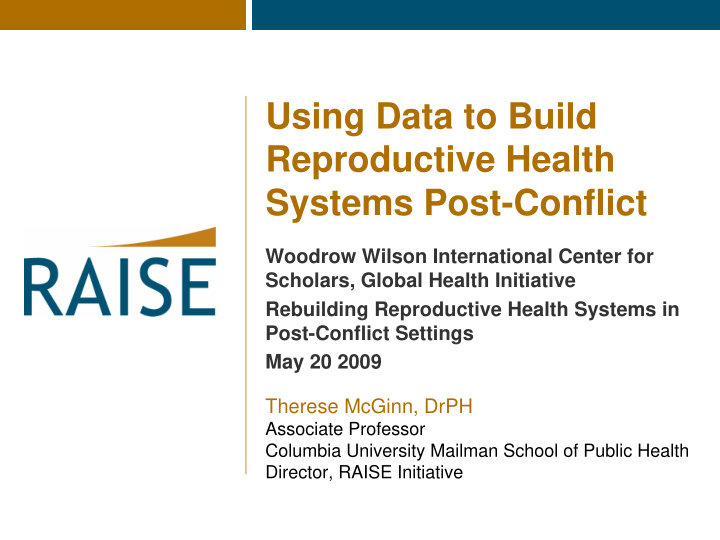



Using Data to Build Reproductive Health Systems Post-Conflict Woodrow Wilson International Center for Scholars, Global Health Initiative Rebuilding Reproductive Health Systems in Post-Conflict Settings May 20 2009 Therese McGinn, DrPH Associate Professor Columbia University Mailman School of Public Health Director, RAISE Initiative
RAISE Initiative • Joint initiative of the Mailman School of Public Health at Columbia University and Marie Stopes International • Aim to address the full range of reproductive health needs for refugees and IDPs through partnerships – Strengthen institutions’ integration of RH – Improve service delivery – Influence global policy and funding decisions
RAISE Partners HQ/Regional Service delivery Policy change systems American Refugee Committee Women’s CARE Commission International Rescue Committee Save the Children-US John Snow Inc MS Uganda UNFPA Mae Tao Clinic Profamilia
RH needs we address � Comprehensive and basic emergency obstetric care, including PAC � Family planning: permanent, long-term and temporary methods including emergency contraception � Reproductive tract infections: diagnosis and treatment and HIV prevention (condoms, VCT, PMTCT, referral) � Gender-based violence: medical response, referral
Countries’ economic status influences the scope and quality of RH care provided Congo, 2007 Afghanistan 2003 Colombia 2007
Where we work in the field Darfur, S Sudan: ARC, IRC, Save the Children Northern Uganda: MSI Colombia: Profamilia DRC: CARE, Thai-Burma IRC Border: Mae Tao Clinic
Example: RH in Congo • Maternal mortality ratio: 549-1100 per 100,000 live births • Major causes of maternal mortality: – Hemorrhage (25%) – Sepsis (15%) – Eclampsia/pre-eclampsia (13%) – Complications of unsafe abortion (13%) • Contraceptive prevalence (modern): 6.7%
Barriers to RH in post-conflict • Weak overall health systems • Long-term lack of community health programs • Policy and funding gaps
When RH is new … By definition, ‘new’ means • Lack of skilled staff • Lack of policy or program guides • Lack of institutional experience • Internal systems must adapt: � Strategic planning � Supervision and support � Program design � Logistics � M&E � Fundraising � Administrative procedures � Partnerships, networks � Staff training
One way to improve care: Better evidence RAISE partners: • Create / enhance use of evidence on-site to improve program management – Standardized across facilities, regions • Contribute to multi-country evidence to advance the field • Provide evidence for advocacy purposes
Better evidence from extensive baseline assessments • In the field sites: – Facility assessments – Population-based surveys • In partner organizations • Global policy and funding trends
Better evidence from improvements in monitoring systems
Data Abstraction Tools
From this… From this… …to this Obstetric Complcations Treated vs. Referred 180 H 160 140 120 Frequency 100 80 60 Obstetric Complications Treated vs. Referred 40 20 180 0 160 140 Jan Feb Mar Apr May Jun Frequency 120 100 80 60 40 20 0 Jan Feb Mar Apr May Jun Month
Using evidence is key • On-site, in each facility and district, among partners • Nationally • Identify policies and protocols that weaken RH - Newer safer technologies - Human resources – who can do what? • Globally, with policy-makers and donors
Ultimately, • Post-conflict countries can use evidence to re-develop their health systems • NGOs and donors must support this development by - Providing technical expertise and support - Engaging on critical policy change
Recommend
More recommend